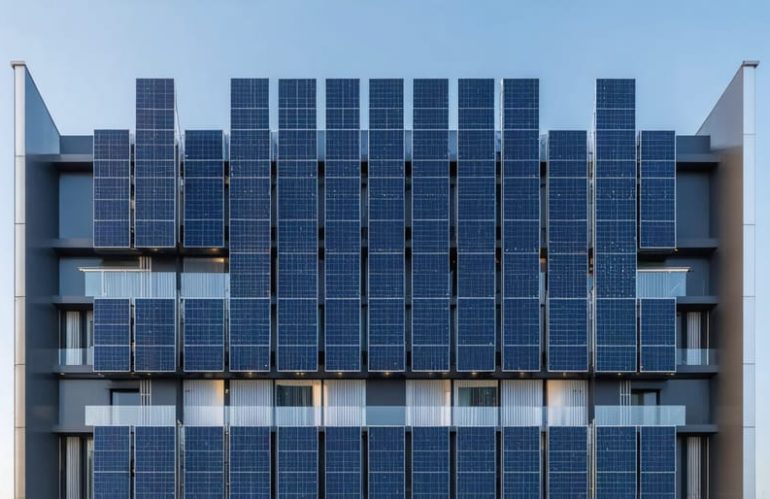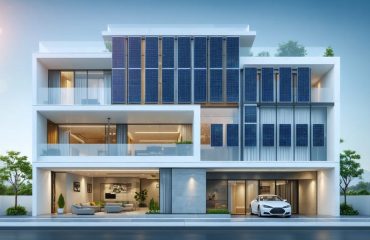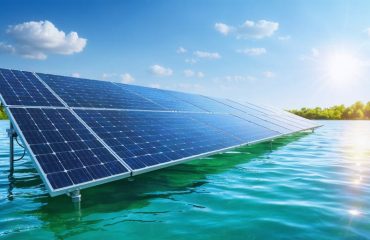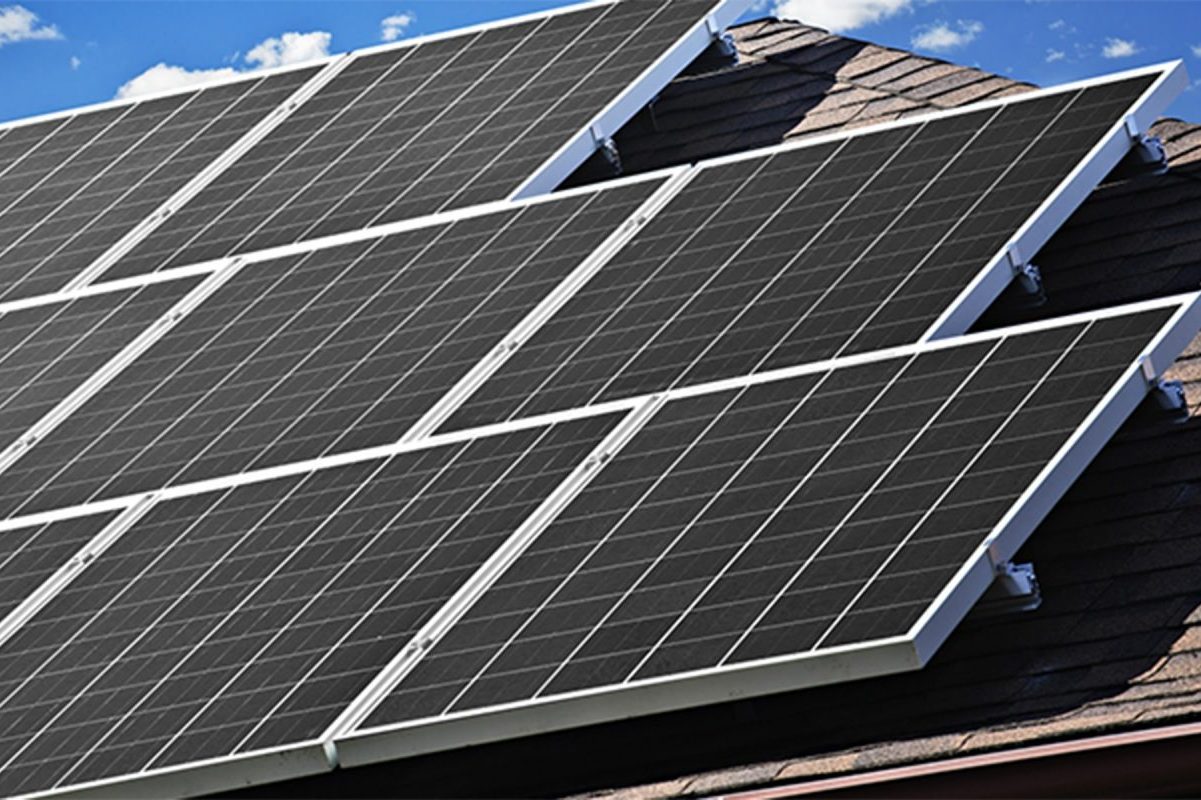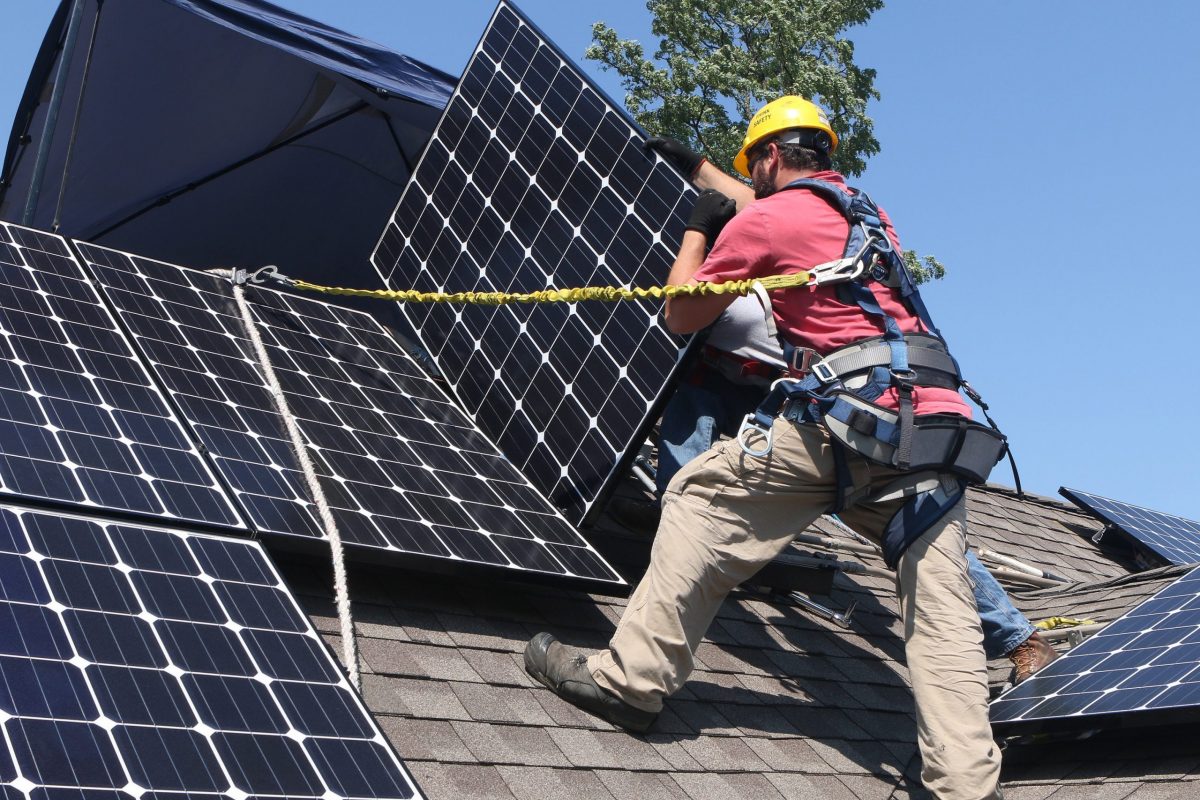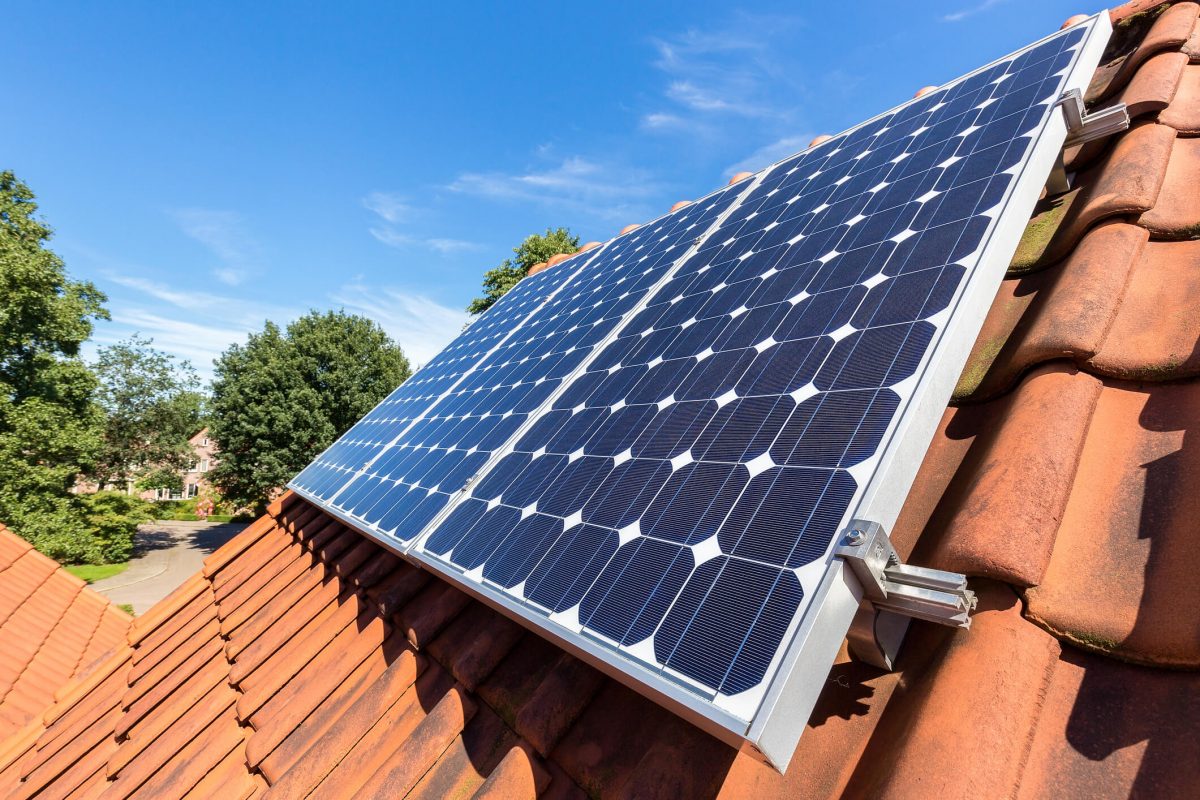Vertical solar panels are revolutionizing urban solar installations, offering a powerful solution for properties with limited horizontal space. By mounting solar panels vertically on walls, fences, or specialized structures, homeowners can harness solar energy while maximizing their available real estate. This innovative approach not only challenges traditional roof-mounted installations but also provides unique advantages in snow-prone regions, where vertical panels remain naturally clear of snow accumulation.
Unlike conventional horizontal installations, vertical solar panels excel in capturing low-angle sunlight during morning and afternoon hours, perfectly complementing peak energy usage patterns in most households. While they may collect slightly less total sunlight throughout the day, their ability to generate power during crucial morning and evening periods often results in more practical energy production for everyday needs.
The aesthetic appeal of vertical installations offers a modern architectural element while serving a practical purpose. These systems can double as privacy screens, noise barriers, or decorative elements, making them particularly attractive for urban environments where space efficiency and visual appeal are equally important. As solar technology continues to advance, vertical mounting represents a smart adaptation to modern energy needs, especially for those seeking innovative solutions to traditional solar installation challenges.
Why Consider Vertical Solar Panels?
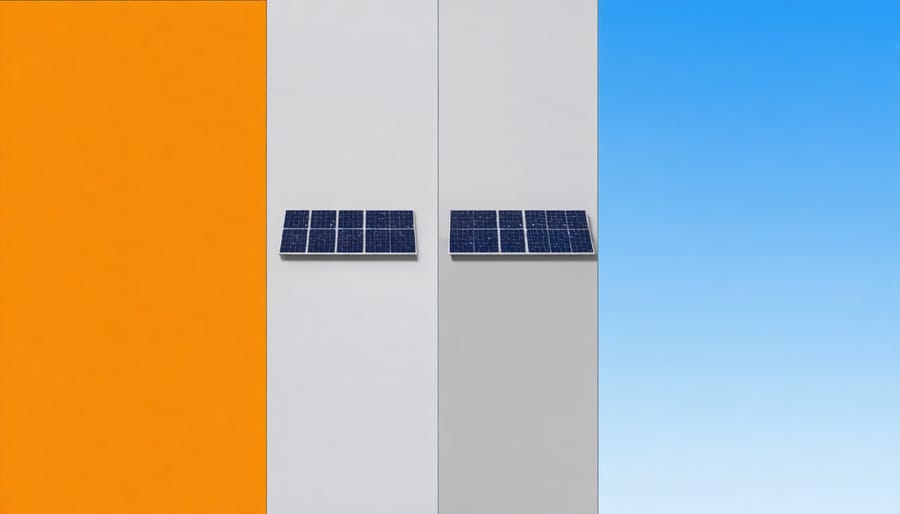
Space Optimization Benefits
Vertical mount solar panels offer innovative solutions for maximizing limited space, making them an excellent choice among alternative solar installations. These installations take advantage of vertical surfaces like walls, fences, and building facades that would otherwise go unused for energy generation. This approach is particularly valuable in urban environments where roof space might be restricted or already occupied by HVAC systems and other equipment.
For homes with unique architectural features, vertical panels can complement existing designs while maintaining aesthetic appeal. They work exceptionally well on structures with tall walls, dormers, or steep roof angles that aren’t suitable for traditional solar installations. Additionally, vertical mounting allows for creative integration with privacy screens, sound barriers, and decorative elements, serving multiple purposes beyond energy generation.
The space-saving benefits extend to properties with limited ground area, where conventional ground-mounted arrays might not be feasible. By utilizing vertical surfaces, homeowners can achieve their renewable energy goals without sacrificing valuable yard space or garden areas, making solar power accessible to a broader range of properties.
Energy Production Advantages
Vertical solar panels offer unique advantages in energy production that complement traditional roof-mounted systems. During morning and evening hours, when the sun sits lower on the horizon, vertical panels capture sunlight more effectively than their tilted counterparts. This timing aligns perfectly with typical household peak energy usage, as families prepare for work in the morning and return home in the evening.
In winter months, vertical panels truly shine. While conventional panels might be covered in snow or receive less direct sunlight due to the sun’s lower position, vertical installations maintain better performance. The steeper angle helps shed snow naturally and captures more of the low-angle winter sunlight, ensuring consistent energy production throughout the year.
Additionally, vertical panels can take advantage of albedo effect – reflecting sunlight from light-colored surfaces like snow or concrete. This reflection can actually boost energy production, making vertical installations particularly effective in snowy regions or areas with reflective surroundings. The result is more reliable year-round energy generation, especially during seasons when traditional solar installations typically underperform.
Key Installation Techniques
Wall Mounting Systems
When mounting solar panels vertically on walls, choosing the right hardware is crucial for both safety and performance. The most common wall mounting systems include rail-based mounts, direct-mount brackets, and adjustable mounting solutions. Rail-based systems provide excellent stability and allow for easier panel alignment, while direct-mount brackets offer a sleeker appearance and can reduce installation costs.
Before installation, it’s essential to assess your wall’s structural integrity. Most exterior walls can support the weight of vertical solar panels, but reinforcement may be necessary for older buildings or walls made of lighter materials. A professional structural assessment can determine if additional support is needed.
The mounting hardware typically includes heavy-duty brackets, mounting rails, clamps, and fasteners specifically designed for vertical installations. These components are usually made from corrosion-resistant materials like aluminum or stainless steel to ensure longevity. Many manufacturers offer complete mounting kits that include all necessary hardware and detailed installation instructions.
For optimal performance, the mounting system should maintain a small air gap between the panels and the wall. This gap allows for proper ventilation and helps prevent heat buildup, which can reduce panel efficiency. Some systems also feature adjustable brackets that enable fine-tuning of the panel angle to maximize sun exposure throughout the year.
Remember to check local building codes and obtain necessary permits before installation, as requirements for wall-mounted solar systems may differ from traditional roof installations.
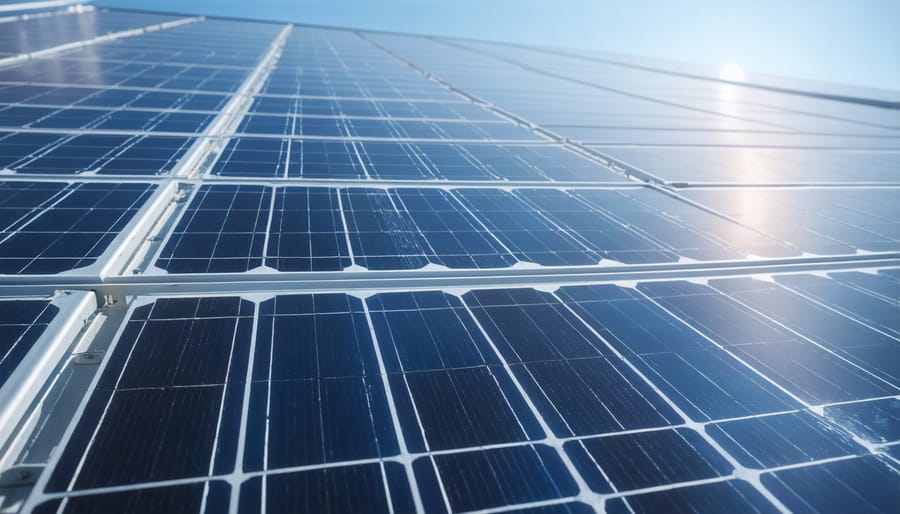
Facade Integration
Vertical solar panels can seamlessly blend with modern architecture through innovative solar-integrated design, transforming building facades into both energy-generating surfaces and aesthetic features. Today’s solar panels come in various colors, textures, and finishes, allowing homeowners to maintain their property’s visual appeal while embracing renewable energy.
Many manufacturers now offer customizable panels that can match existing building materials, from sleek glass surfaces to traditional brick patterns. These panels can be incorporated into window installations, creating a dual-purpose solution that provides both natural light and energy generation. Some designs even feature semi-transparent options, perfect for creating sun-filtered spaces while harvesting solar power.
The integration process typically involves working with both solar installers and architects to ensure the panels complement the building’s overall design. This collaboration often results in solutions that enhance rather than detract from the property’s appearance. Popular options include using panels as decorative elements, incorporating them into awnings, or creating striking geometric patterns across building surfaces.
Modern mounting systems allow for precise panel positioning and spacing, ensuring a clean, professional look that adds value to your property. These systems also make maintenance and cleaning easier, preserving both functionality and aesthetics over time.
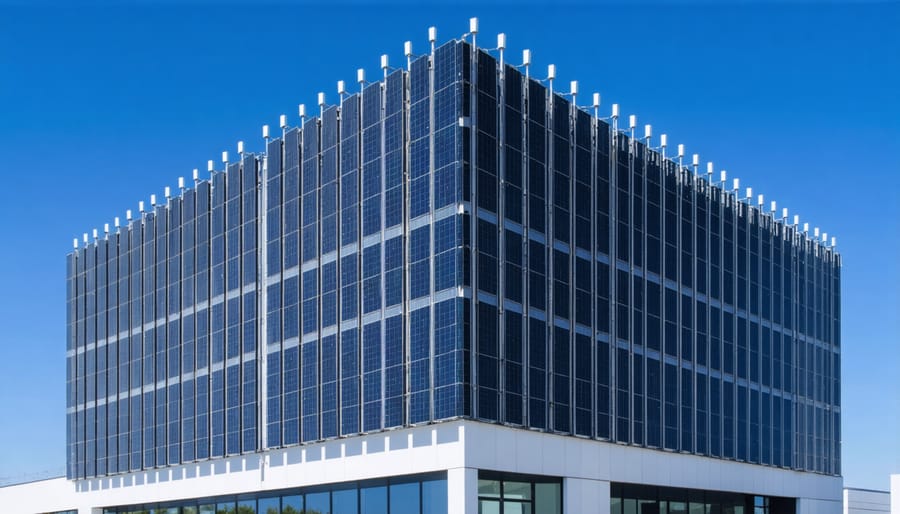
Safety and Support Requirements
When installing vertical solar panels, safety and proper support are paramount to ensure long-term reliability and protection. Start by having a qualified structural engineer assess your wall’s load-bearing capacity. Most exterior walls can support vertical panels, but reinforcement may be necessary in some cases.
The mounting system must be rated for vertical installation and weather-resistant, typically using corrosion-resistant aluminum or stainless steel brackets. These should be anchored directly into wall studs or structural supports, never just into siding or masonry veneer. Space brackets according to manufacturer specifications, usually every 4-6 feet, to distribute weight evenly.
Install proper flashing around mounting points to prevent water infiltration, and use appropriate sealants rated for outdoor use. Ensure all electrical connections are weatherproof and comply with local electrical codes. Ground-fault protection is essential, as is proper cable management to prevent wear from wind movement.
Safety equipment for installation includes fall protection gear when working at heights, proper lifting equipment, and protective clothing. Consider wind loads in your area – vertical panels may need additional bracing in high-wind regions.
Regular maintenance checks should focus on bracket integrity, signs of water damage, and secure electrical connections. Keep mounting areas clear of vegetation and debris that could compromise structural integrity or create fire hazards.
Optimizing Performance
Ideal Positioning and Angle
The optimal positioning of vertical solar panels requires careful consideration of several key factors to maximize energy generation. While traditional roof-mounted panels typically face south in the Northern Hemisphere, vertical installations offer unique advantages when positioned strategically. East and west-facing vertical panels can capture sunlight during morning and afternoon hours, making them particularly effective for urban solar applications where roof space may be limited.
For best results, ensure your vertical panels have a clear line of sight to the sun’s path, avoiding shadows from nearby buildings or trees. The ideal angle for vertical mounting is typically 90 degrees from the ground, though slight adjustments between 75-85 degrees might be beneficial in some cases to improve solar collection and facilitate natural cleaning from rainfall.
Consider your geographical location when planning vertical installations. In higher latitudes, vertical panels can actually outperform traditional installations during winter months, as they’re better positioned to capture the low-angle winter sun. They also excel in snowy regions, as snow slides off more easily compared to tilted panels.
For buildings with multiple façades, installing panels on different sides can help maintain consistent energy production throughout the day. This approach is particularly effective for commercial buildings with high daytime energy demands, as it creates a more balanced power generation profile.
Maintenance Requirements
Vertical solar panels actually require less maintenance than their traditional horizontal counterparts, making them an attractive option for busy homeowners. Since they’re mounted at a steep angle, rain naturally washes away dirt, dust, and debris more effectively, reducing the frequency of manual cleaning.
For optimal performance, inspect your vertical panels quarterly and clean them as needed. A simple visual check can help identify any dirt buildup or potential issues. When cleaning is necessary, use a soft brush or cloth with mild soap and water during cooler morning hours. Avoid harsh chemicals or abrasive materials that could damage the panel surface.
In snowy regions, vertical panels have a natural advantage – snow slides off easily, eliminating the need for manual snow removal. However, check occasionally to ensure snow hasn’t accumulated at the base of the panels.
Regular maintenance should include:
– Checking for loose mounting hardware
– Ensuring vegetation hasn’t grown to block the panels
– Inspecting seals and connections for weather damage
– Monitoring performance through your inverter system
Professional inspection is recommended annually to verify electrical connections and mounting integrity. This helps maintain optimal efficiency and extends the life of your investment. Remember to keep records of maintenance activities and any changes in performance to track long-term efficiency.
Cost Considerations
Installation Costs vs. Traditional Mounting
When comparing costs, vertical solar panel installations often present a more budget-friendly option than traditional roof-mounted systems. The initial hardware costs are typically 10-15% lower since vertical mounts require less complex mounting equipment and fewer penetrations into building structures. Labor costs can also be reduced because installation is generally more straightforward and safer, with workers operating at ground level rather than on rooftops.
However, it’s important to note that the total cost will vary depending on your specific situation. While the mounting hardware and installation may be less expensive, you might need more panels to achieve the same energy output as traditional installations, due to reduced sun exposure. This difference can be offset by lower maintenance costs over time, as vertical panels are easier to clean and less likely to accumulate debris.
For a typical residential installation, expect to pay between $2.50 and $3.00 per watt for vertical systems, compared to $2.80 to $3.50 per watt for traditional roof mounts. This calculation includes materials, labor, and standard electrical work. Remember to factor in potential incentives and tax credits, which usually apply regardless of mounting orientation.
Long-term Financial Benefits
Investing in vertical mount solar panels can offer substantial financial returns over time. While initial installation costs may be higher than traditional rooftop systems, vertical panels often deliver impressive long-term value through multiple revenue streams. Homeowners can maximize energy savings through reduced electricity bills, with many seeing a complete return on investment within 5-7 years.
The vertical orientation can be particularly advantageous in northern climates, where low-angle winter sun provides optimal energy generation during months with highest energy demands. This seasonal alignment often results in more consistent year-round energy production compared to traditional installations. Additionally, many states offer tax incentives and rebates specifically for innovative solar installations, further improving the financial outlook.
Maintenance costs tend to be lower for vertical panels as they naturally shed snow and collect less dust and debris. Their durability and longer lifespan, often exceeding 25 years, contribute to a better overall return on investment. When combined with net metering programs, homeowners can potentially eliminate their electricity bills while earning credits for excess energy production.
Vertical solar panels represent an innovative solution that’s reshaping how we think about solar energy installation. By maximizing available wall space and offering unique advantages like snow-shedding capabilities and consistent energy production throughout the day, vertical mounting opens new possibilities for homeowners who previously thought solar wasn’t viable for their situation.
The benefits are clear: reduced maintenance requirements, protection from severe weather, optimal performance during winter months, and the ability to harvest energy during peak morning and evening hours. For urban dwellers with limited roof space or those in snowy regions, vertical installations can be a game-changing alternative to traditional roof-mounted systems.
While initial costs may be comparable to conventional installations, the long-term advantages often justify the investment. From enhanced aesthetic appeal to improved energy independence, vertical solar panels offer a practical solution that aligns with modern architectural trends while delivering reliable renewable energy.
As we continue to face growing energy demands and environmental challenges, vertical solar installations present a forward-thinking approach to sustainable living. Whether you’re considering solar for the first time or looking to expand your existing system, vertical mounting deserves serious consideration. By embracing this innovative installation method, you’re not just investing in your home’s energy future – you’re participating in the evolution of solar technology.
Take the next step toward energy independence by consulting with local solar installers about vertical mounting options for your property. The future of solar is expanding beyond the rooftop, and the possibilities are looking brighter than ever.

